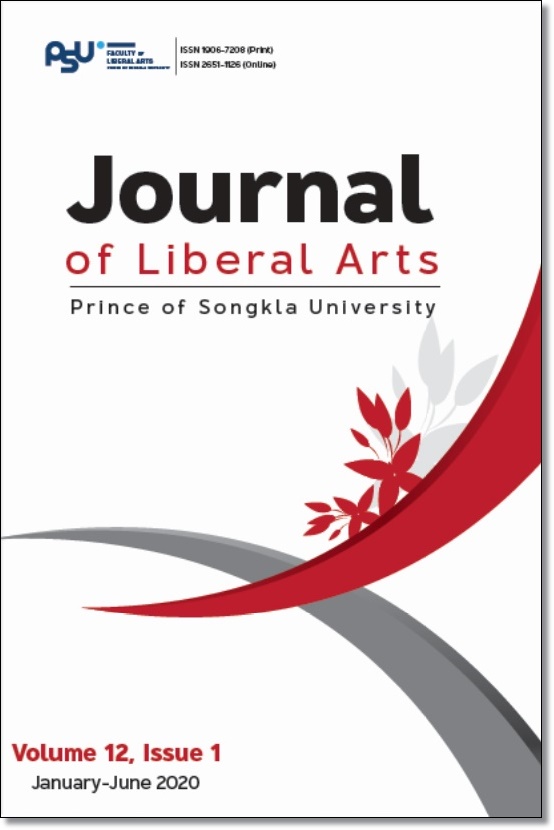Thai Wisdom Activities to Promote Peace Culture
Keywords:
art education, peace culture, Thai art, Thai wisdom activitiesAbstract
This article aims to propose a form of using cultural diversity advantages to promote understanding in society to create a peace culture involving the concept of living with compassion and nonviolent behavior towards others through the development of art education activities based on the Thai wisdom art. Cultural diversity is advantageous for society. However, lack of effective management of cultural diversity may lead to conflicts in society such as miscommunication, cultural misunderstanding, cultural barriers, discrimination, and cultural right violation. To prevent the undesired cultural diversity phenomenon; therefore, this article proposes the Thai Wisdom-Based Model of Art Activity. The model concerns the preservation of regional cultural identity and local tradition. The activities consist of three topics which are fine art, popular art, and folk art. It is believed that the art activity and peace culture can develop the right understanding of the Thai cultural diversity that will yield three benefits for Thai peace culture:
1) a harmony of love, trust, and respect for identity, 2) intimacy and equality, and 3) appreciation and participation.
References
Anderson, T., & Conlon, B. (2013). In the shadow of the peace walls: Art, education, and social reconstruction in northern Ireland. Art Education, 66(4), 36-42.
Angkanit, A. (2014). Effects of organizing participatory non-formal education activities to develop folk plays integrating with local wisdoms on social skills of children in the community. Online Journal of Education, 9(4), 27-40. [in Thai]
Bae, J. (2012). An intercultural peace mural project: Lets make a peaceful world hand in hand. Art Education, 65(1), 47-54.
Barkhordari, M. (2016). The importance of art-based curriculum in peace education. Faculty of Education and Psychology. University of Isfahan.
Chang, R. (2005). Culture and art education in China. International Journal of Education through Art, 1(3), 225–236.
Feldman, E.B. (1995). Philosophy of art education. (1sted). United States of America.
Issifu, A. K. (2016). Local peace committees in Africa: The unseen role in conflict resolution and peacebuilding. The Journal of Pan African Studies, 9(1), 141-158.
Jensantikul, N. (2015). Ethnic diversity with ASEAN community: Problems and considerations. Executive Journal, 35(2), 33-45. [in Thai]
Jitpiromsri, K. (2015). Peace education: Roles and activities on conflict transformation. Journal of Learning Innovation, 1(1), 53-76. [in Thai]
Kose, C.T. & Bayir, G.O. (2016). Perception of peace in students’ drawings. Eurasian Journal of Educational Research, 65, 181-198
Makkarapirom, P. (2012). Peace culture. Institute of Human Rights and Peace Studies. [in Thai]
Margolin, V. (1992). Product appeal and the aura of art. In Objects and Images: Studiesin Design and Advertising. S. Vihma (ed.), Helsinki: University of Industrial Arts. (pp. 198-207)
Marshall, L. (2014). Art as peace building. Art Education, 67(3), 37-43.
Ministry of Education. (2010). Guidelines for bringing Thai wisdom into the informal learning process: School and informal learning. Community of Agricultural Cooperatives of Thailand. [in Thai]
Nakhonthap, O., & Pongpakatien, J. (2008). Peace culture and culture in one's self: concepts and guidelines for enhancing health and learning about peace. Ramajitti Institute. [in Thai]
Na Talang, A. (2001). Overview of Thai wisdom. Wisdom foundation. [in Thai]
Promkul, S. (2015). The Peace building in community by local Knowledge: A case study Bunloung Tradition Loei Province. Developing the Quality of Thai Research to the International Standards. [in Thai]
Saranukromthai for Students. (2017). Thai wisdom. Thai Junior Encyclopedia Project by Royal Command of H.M. the King (Volume 23). Bangkok. http://saranukromthai.or.th/sub/book/book.php?book=23&page=main. [in Thai]
Tolstoy, L.N. (1960). What is art (A. Maude, trans). lated by Almyer Maude. MacMillan Publishing Company.
Tavin, K. (2014). Art education is violent. Art Education, 67(3), 44-45.
Visetsuvarnabhumi, K. (2015). Research and learning network development for youths’ peaceful cultural creation in southern border provinces: a case study of Pattani. Parichart Journal, 28(3), 50-63. [in Thai]
Witayanont, N. (2013). An educational management model of basic education schools for peace in the southern border. Suddhiparitad Journal, 26(79), 151-166. [in Thai]
Downloads
Published
How to Cite
Issue
Section
License
The authors retain the copyright to their article but the Journal of Liberal Arts, Prince of Songkla University reserves the exclusive rights to first publication.






